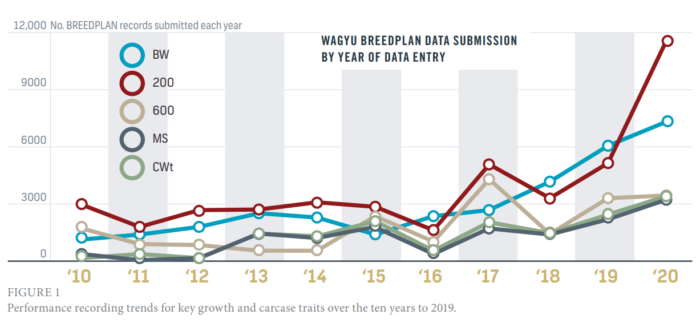ADDRESSING COMMON TRAIT RECORDING ISSUES TO MAXIMISE YOUR DATA VALUE
Over the last 3 years, the number of Wagyu Breeders who record trait performance data on their herds has increased significantly. Many members record and then submit this to the AWA for inclusion in the BREEDPLAN genetic analysis.
Trait performance data is a critical component for generating AWA BREEDPLAN EBVs (see Bloodline vs Pedigrees article). Trait data is vital to our genetic analysis. AWA members are increasingly submitting their performance data for a wide range of birth, fertility, growth and carcase traits to improve the analysis and the accuracy of EBVs for the animals in their herds. Figure 1. below shows the trends in the number of performance records submitted each year for a selection of Wagyu traits over the past decade. The number of AWA members that are enrolled as BREEPLAN data contributors has increased by 70% over the last two years, to over 150 active data contributors. Although the trends for performance recording and data submission to Wagyu BREEDPLAN continue to increase over recent years, it is important that the data provided by members is able to be used in BREEDPLAN so that they obtain the maximum benefit from their efforts.

Some AWA members report that although collecting data might be easy or routine within their cattle operations, understanding the requirements for that data to be useful within the AWA BREEDPLAN analysis is not as straight forward.
RECORDING DATA IN MANAGEMENT GROUPS An overriding requirement for members seeking to get the most out of their data by submitting it to AWA BREEDPLAN, is to record as many animals as possible in a management group at the same time. It is also important to keep animals in the management group together for as long as possible, so that your data is as useful as possible.
A fundamental aspect of genetic analyses is the comparison of animals within management groups to determine genetic differences between animals. Only animals that have had an equal opportunity to perform are directly compared together within BREEDPLAN.
There are two different forms of breeder defined management groups:
1. The “Birth Management Group” allows breeders to describe different treatments of the cows prior to the birth of the calf. For example, where one group of cows have had different feed availability that may affect the birth weight and/or calving ease and/or gestation length when the calf is born.
2. The “Post Birth Management Group” allows breeders to identify animals that have received different treatment or management following birth that has influenced their performance. This treatment may be deliberate (eg when some of your young bulls are castrated or receive supplementary feeding and others do not) or accidental (eg if a calf is sick).
WHY IS MANAGEMENT GROUP IMPORTANT?
Put simply, if you weigh animals on separate days in separate management groups, genetic analyses do not compare individuals between different groups on different dates. For example, if you weigh a paddock of steers on one day, BREEDPLAN can compare the weights of those steers to determine genetic merit if they are in one management group.
If you also weigh a paddock of heifers on the same day, BREEPLAN can compare the weights of the heifers to determine their genetic merit. However, BREEDPLAN will not compare the steer weights to the heifer weights directly, but it will use the information from both the steer and heifer groups in calculating EBVs.
The point here is that if possible, keep your management groups as large as possible for as long as possible, so that the comparative information within your management group data is most effective within BREEDPLAN.
TIPS ON TRICKY TRAITS
The following information is taken from excellent resources developed by Southern Beef Technology Services (SBTS) and was provided by Ms Catriona Millen. The source information can be found in the BREEDPLAN Help Centre – Recording Performance page.
RECORDING BIRTH WEIGHTS
Birth Weight EBVs are estimates of genetic differences between animals in calf birth weight. Birth Weight EBVs are expressed in kilograms (kg) and are calculated from the birth weight of calves.
WHY SHOULD BIRTH WEIGHTS BE RECORDED?
Firstly, if you are recording birth weight, you are obtaining an accurate date of birth on the calf. Accurate birth dates are essential within BREEDPLAN as they provide the basis for calculating 200, 400 and 600 day weight accurately and birth date is used for comparing animals of similar ages within
management groups.
Birth Weight is also an important component of calving ease. If birth weights of calves are too high, this can start to result in calving difficulty. Calving difficulty has an obvious negative impact on the profitability of a herd through increased calf and heifer mortality, slower re-breeding performance and considerable additional labour and veterinary expense. Conversely, if birth weight of calves is too low, this can lead to weak calves with poor resilience and ultimately, calf survival issues.
WHAT CONSIDERATIONS SHOULD BE MADE WHEN RECORDING BIRTH WEIGHTS?
Birth weight should be recorded for the whole calf crop. Without comparisons to the other calves, “occasional” measurements are of no value and can actually be misleading. There are significant fluctuations in the weight of a calf over its first week of life. Therefore, it is important to weigh calves as close to birth as possible. Ideally, measure birth weight within 24 hours of birth. Do not guess birth weight or use girth/chest size to estimate birth weight. Either weigh the calves or don’t record birth weight. A birth management group should be recorded if there are different treatments of the females prior to calving that may affect birth weight. For example, where one group of cows have had different feed availability. A separate birth management group should also be assigned if the weight of the calf has been affected by special circumstances (e.g. premature calves, the dam was sick etc.) Be wary of protective cows while weighing calves. It is important to take due care when collecting this information.
